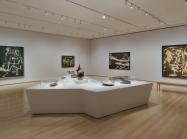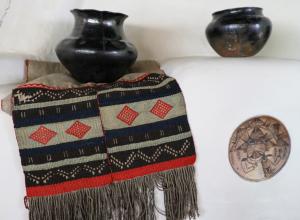“There’s always a work or a mixture of works that you’re happy to see. It’s a mixture between what the curator wants and my suggestions,” Kentridge tells Art & Object as he wanders through the installation, gazing at charcoal renderings. “It’s not like the point of a pencil. You can’t tell it where to go in the same way. You have got to take on trust where the nub of the charcoal is actually hitting the paper.”
The medium’s malleability allows Kentridge to alter his images with a wipe of a cloth, executing ideas as quickly as they come to him. It wasn’t his original intention to do animation; nor did he intend on photography – he initially employed a camera only to track the process of a drawing in an effort to pinpoint where it begins to go wrong.
“Very often something that’s really gone bad is a great help because then you feel nothing about tearing it up, rearranging it, cutting into fours, and putting it in different positions. Whereas if a drawing is going well, it suddenly gets precious and you start drawing very meekly and cautiously so as not to mess up what you’ve done."






























